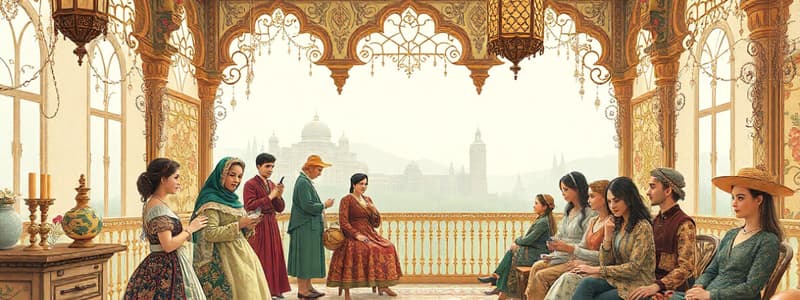Podcast
Questions and Answers
Describe how culture is dynamic and why exchange of ideas is important.
Describe how culture is dynamic and why exchange of ideas is important.
Culture is dynamic because it changes over time as people interact and share ideas, which is crucial for growth and development.
What role does flexibility play in cultural interactions?
What role does flexibility play in cultural interactions?
Flexibility allows individuals to interact across cultural and social borders, essential for building relationships in various environments.
Explain the concept of adaptability in the context of culture.
Explain the concept of adaptability in the context of culture.
Adaptability is the willingness to embrace change as part of life, indicating an openness to cultural evolution.
How does enculturation contribute to socialization?
How does enculturation contribute to socialization?
List two examples of patterned social interactions.
List two examples of patterned social interactions.
What does it mean for integration to occur between cultures?
What does it mean for integration to occur between cultures?
In what ways are cultural norms transmitted through socialization?
In what ways are cultural norms transmitted through socialization?
Why can cultural practices be both shared and contested?
Why can cultural practices be both shared and contested?
How does culture influence the way people perceive reality?
How does culture influence the way people perceive reality?
What distinguishes non-material culture from material culture?
What distinguishes non-material culture from material culture?
Identify and explain the role of symbols in a culture.
Identify and explain the role of symbols in a culture.
What are the five components of culture as identified in sociology?
What are the five components of culture as identified in sociology?
How do values within a society define acceptable behavior?
How do values within a society define acceptable behavior?
Explain the importance of language in culture.
Explain the importance of language in culture.
Can society exist without culture? Justify your response.
Can society exist without culture? Justify your response.
What are norms, and how do they relate to culture?
What are norms, and how do they relate to culture?
How are culture and society differentiated in the context of their influence on identity?
How are culture and society differentiated in the context of their influence on identity?
What distinguishes material culture from non-material culture? Provide an example of each.
What distinguishes material culture from non-material culture? Provide an example of each.
In what ways does technology influence cultural change?
In what ways does technology influence cultural change?
Are symbols in culture always physical? Explain your reasoning.
Are symbols in culture always physical? Explain your reasoning.
Discuss the nature of language in relation to culture. Can it be both oral and written?
Discuss the nature of language in relation to culture. Can it be both oral and written?
Is it accurate to say that culture cannot be shared among individuals? Why or why not?
Is it accurate to say that culture cannot be shared among individuals? Why or why not?
What role does a flag play within a nation's culture?
What role does a flag play within a nation's culture?
Why might norms in a culture change over time?
Why might norms in a culture change over time?
According to Edward Tylor, what does culture encompass?
According to Edward Tylor, what does culture encompass?
What influences the total number of roles a person occupies?
What influences the total number of roles a person occupies?
What is cultural transmission and how is it related to cultural learning?
What is cultural transmission and how is it related to cultural learning?
Why is all culture considered learned rather than inherited?
Why is all culture considered learned rather than inherited?
What does cultural integration involve?
What does cultural integration involve?
What is the significance of respect in shared culture?
What is the significance of respect in shared culture?
List two aspects that characterize culture as described in the content.
List two aspects that characterize culture as described in the content.
How does language play a role in culture?
How does language play a role in culture?
What are two types of threats to cultural heritage and give an example of each?
What are two types of threats to cultural heritage and give an example of each?
Describe one method of archaeological preservation.
Describe one method of archaeological preservation.
What role does digital imaging play in preserving cultural heritage?
What role does digital imaging play in preserving cultural heritage?
Identify one Filipino intangible cultural heritage practice worth preserving and explain its significance.
Identify one Filipino intangible cultural heritage practice worth preserving and explain its significance.
Suggest a plan of action to address a threat to a tangible cultural heritage site.
Suggest a plan of action to address a threat to a tangible cultural heritage site.
How does silence contribute to effective communication?
How does silence contribute to effective communication?
What is ethnocentrism and how does it affect cultural interactions?
What is ethnocentrism and how does it affect cultural interactions?
Define cultural relativism and its significance in understanding different cultures.
Define cultural relativism and its significance in understanding different cultures.
What constitutes tangible cultural heritage?
What constitutes tangible cultural heritage?
What does intangible cultural heritage encompass?
What does intangible cultural heritage encompass?
Explain the impact of culture on human behavior.
Explain the impact of culture on human behavior.
Discuss the relationship between culture and society as a complex whole.
Discuss the relationship between culture and society as a complex whole.
How can cultural practices be evaluated according to cultural relativism?
How can cultural practices be evaluated according to cultural relativism?
Flashcards
Society
Society
A group of people who share a defined territory and a culture. It encompasses social structures, interactions, and relationships between individuals and institutions within that group.
Culture
Culture
Socially transmitted ways of thinking, believing, feeling, and acting within a group of people that are passed from one generation to the next. It shapes people's understanding of reality and influences their lives.
Material Culture
Material Culture
The physical and tangible objects created and used by humans in a culture. Examples include tools, clothing, dwellings, and artifacts.
Non-material Culture
Non-material Culture
Signup and view all the flashcards
Symbols
Symbols
Signup and view all the flashcards
Language
Language
Signup and view all the flashcards
Beliefs
Beliefs
Signup and view all the flashcards
Norms
Norms
Signup and view all the flashcards
Values
Values
Signup and view all the flashcards
Technology's Impact on Culture
Technology's Impact on Culture
Signup and view all the flashcards
What is Culture?
What is Culture?
Signup and view all the flashcards
Cultural Learning
Cultural Learning
Signup and view all the flashcards
Cultural Integration
Cultural Integration
Signup and view all the flashcards
Shared Culture
Shared Culture
Signup and view all the flashcards
Dynamic Culture
Dynamic Culture
Signup and view all the flashcards
Shared and Contested Culture
Shared and Contested Culture
Signup and view all the flashcards
Socialization or Enculturation
Socialization or Enculturation
Signup and view all the flashcards
Culture: Inherited or Learned?
Culture: Inherited or Learned?
Signup and view all the flashcards
Theft of Cultural Heritage
Theft of Cultural Heritage
Signup and view all the flashcards
Archaeological Preservation
Archaeological Preservation
Signup and view all the flashcards
Legal and Protective Measures
Legal and Protective Measures
Signup and view all the flashcards
Digital Imaging in Cultural Heritage
Digital Imaging in Cultural Heritage
Signup and view all the flashcards
Weathering
Weathering
Signup and view all the flashcards
Ethnocentrism
Ethnocentrism
Signup and view all the flashcards
Cultural relativism
Cultural relativism
Signup and view all the flashcards
Tangible cultural heritage
Tangible cultural heritage
Signup and view all the flashcards
Intangible cultural heritage
Intangible cultural heritage
Signup and view all the flashcards
Communication
Communication
Signup and view all the flashcards
Active listening
Active listening
Signup and view all the flashcards
Illustrative interpretation
Illustrative interpretation
Signup and view all the flashcards
Culture is Dynamic
Culture is Dynamic
Signup and view all the flashcards
Culture is Adaptive
Culture is Adaptive
Signup and view all the flashcards
Culture is Shared and Contested
Culture is Shared and Contested
Signup and view all the flashcards
Enculturation: Learning Culture
Enculturation: Learning Culture
Signup and view all the flashcards
Socialization: Becoming Part of a Culture
Socialization: Becoming Part of a Culture
Signup and view all the flashcards
Society: A System of Interactions
Society: A System of Interactions
Signup and view all the flashcards
Integration: Blending Cultures
Integration: Blending Cultures
Signup and view all the flashcards
Transmission of Culture Through Socialization
Transmission of Culture Through Socialization
Signup and view all the flashcards
Study Notes
Defining Culture and Society
- Culture is the complex whole of a society, encompassing aspects that shape its identity.
- Culture influences beliefs and behaviors, being a key concept in sociology.
- Culture and society are intertwined and interconnected phenomena.
- Society is the collaboration of people, while culture adds meaning to relationships.
- Culture is defined as "that complex whole which includes knowledge, beliefs, arts, morals, law, custom, and any other capabilities and habits acquired by man as a member of society." (Edward Tylor)
- People occupy multiple roles (child, sibling, worshiper, employee, friend, spouse, voter, student).
- The number of roles reflects the quantity of networks individuals are involved in.
- Culture is the human face of society, encompassing shared customs, values, beliefs, norms, and behavior, shaped over time.
- Culture is learned, not inherited.
- Cultural learning is known as cultural transmission and is influenced by how cultures socialize children and young people.
Components of Culture
- Symbols: Physical or non-physical features used to represent objects, functions, or processes. They convey meanings to things and events.
- Language: Used for communication; both verbal and nonverbal forms carry meaning and purpose. Variations in meaning exist across regions.
- Beliefs: Convictions considered real or true, regardless of evidence. Often related to religious needs and faith in a supreme being, or superstitions.
- Values: Accepted standards of conduct within a society. Guiding principles for behavior and judgments about what's important in life. Represent enduring beliefs about what is good or bad, desirable or undesirable.
- Norms: Rules, customs, and traditions within a culture. Both written and unwritten rules that guide moral standards, manners, and conduct within situations and/or circumstances of everyday life, or that relate to routine aspects of day-to-day life. Norms are also described as informal guidelines for what's considered acceptable or unacceptable social behavior within a group and can change over time with the development of laws and regulations.
Kinds of Culture
- Material Culture: Tangible and concrete artifacts created and used by people. Examples include dwellings, weapons, tools, clothing, relics, fossils, and artifacts. Study in anthropology.
- Non-material Culture: Intangible aspects, including behavior, knowledge, customs, traditions, beliefs, laws, and lifestyle. Study in sociology.
Cultural Heritage
- Tangible Heritage: Physical artifacts, buildings, monuments, and other tangible products of creativity that hold cultural significance in a society.
- Intangible Heritage: Practices, representations, expressions, knowledge, skills, instruments, objects, artifacts, and cultural spaces. Examples include oral traditions, performing arts, local knowledge, and traditional skills.
Threats to Cultural Heritage
- Man-made Threats: Destruction from conflict, construction, development, neglect, and theft of artifacts for financial gain.
- Natural Threats: Environmental damage due to climate change, and weathering of stone structures.
Ways to Address Threats
- Archaeological Preservation: Physical excavation and preservation of historical artifacts.
- Museums: Preservation and display of artifacts.
- Digital Imaging: Supplementary and more detailed information about historical artifacts.
- Legal Protection: Laws and regulations to safeguard artifacts.
Filipino Cultural Traditions
- Pagmamano: Respectful blessing of the elders' hands.
- Traditional Games: Preserving Filipino games.
- Giving Seats to Elders and Women: Demonstrating respect for elders and women.
- Harana: Filipino serenading tradition.
Society and Culture as a Complex Whole
- Society is the collaboration of people. Culture adds meaning to relationships, and shapes behavior.
- Culture is dynamic, flexible, and adaptive, changing over time.
- Culture is learned, not inherited.
- Culture is shared and contested, encompassing differing ideas and perspectives.
- Shared culture involves the processes of enculturation and socialization, processes used by people to integrate another culture, while also upholding their own culture.
Ethnocentrism vs. Cultural Relativism
- Ethnocentrism: Judging other cultures by one's own culture as the standard. "My culture is best."
- Cultural Relativism: Viewing cultures in terms of their own context; every culture is valid. "Every culture is equally valid."
Studying That Suits You
Use AI to generate personalized quizzes and flashcards to suit your learning preferences.




